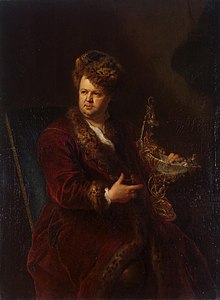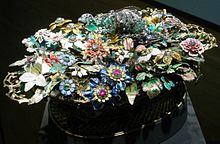Johann Melchior Dinglinger
Johann Melchior Dinglinger (born December 26, 1664 in Biberach an der Riss ; † March 6, 1731 in Dresden ) was court goldsmith in Dresden with Elector Augustus the Strong of Saxony .
Life
Johann Melchior Dinglinger learned the goldsmith's trade in Ulm . He came to Dresden in 1692 as a journeyman , where he was accepted into the goldsmith's association in 1693. In 1698 he was appointed court jeweler August the Strong. He worked in Dresden until his death in 1731, was married five times and had 23 children. His grave with a Schwibbogen on the old Johanniskirchhof has not been preserved.
Dinglinger is considered one of the most important baroque goldsmiths . Together with 14 journeymen, Dinglinger created magnificent pieces of art in his workshop, including the “Golden Coffee Stuff” and the “Court of Delhi” with its 132 figures - a masterpiece of baroque jewelery art. The Russian Tsar Peter the Great also appreciated the magnificent work and gave several orders to the Dresden court jeweler.
With the Dinglinger Fountain , the jeweler set a special kind of monument. Its original location was on a courtyard wall at Frauengasse 9. Dinglinger lived here. The house was one of Dresden's sights because of its curiosities - an observatory, weather clock and fire engine. During the Seven Years' War the house was set on fire and later rebuilt. During the Second World War, all the buildings in the Neumarktviertel were largely destroyed, including the Dinglingerhaus . The fountain was preserved and has been attached to the Gewandhaus since 1966 . Dinglinger also owned a country house with a vineyard in Loschwitz , Dinglinger's vineyard on today's Schevenstrasse.
Works

His magnificent works, for example "The golden coffee stuff" from 1701 or the "Bath of Diana", are preserved in the Green Vault in Dresden.
Dinglinger created his most famous work together with his brothers, the enameller Georg Friedrich (1666–1720) and the jewelery specialist Georg Christoph (1668–1728) as well as the assistants in his workshop over eight years between 1701 and 1708: The “Hofstaat zu Delhi on the birthday of the Grand Mogul Aureng-Zeb ”; it consists of 132 gold, enamelled figures, adorned with 5,223 diamonds, 189 rubies, 175 emeralds, 53 pearls and a sapphire. Dinglinger created the work without commission and sold the cabinet piece to August the Strong for 60,000 thalers. This horrific sum was after the occupation of Saxony by Karl XII. difficult to afford from Sweden for August. By 1713 most of the sum had been paid.
- Dinglinger's works in the Green Vault in Dresden
literature
- Carl Clauß: Dinglinger, Johann Melchior . In: Allgemeine Deutsche Biographie (ADB). Volume 5, Duncker & Humblot, Leipzig 1877, p. 240 f.
- Paul Beck : The Dinglinger family of artists from Biberach a. R. (= Swabian Biographies; 18. – 20.) , In: Diöcesanarchiv von Schwaben , 16. Jg. 1898, Issue 7, pp. 97–105 ( digitized version )
- Walter Holzhausen : Dinglinger, Johann Melchior. In: New German Biography (NDB). Volume 3, Duncker & Humblot, Berlin 1957, ISBN 3-428-00184-2 , p. 730 f. ( Digitized version ).
- Erna von Watzdorf : Johann Melchior Dinglinger. The goldsmith of the German Baroque. 2 volumes. Gebr. Mann, Berlin 1962.
- Dirk Syndram : The Throne of the Great Mogul in the Green Vault of Dresden, Verlag EA Seemann, 2009
- Tobias Knobelsdorf: "In the Dinglerischer Hauß in Dreßden, which is famous for its many sights." New findings on the structural design and equipment of the Dinglingerhaus in Dresden's Frauenstrasse. In: Die Dresdner Frauenkirche, year book on their past and present, vol. 16, 2012, pp. 101–114. ISBN 978-3-7954-2655-2
- Martin Eberle: Johann Melchior Dinglinger in Dresden (= stations 5). Mitteldeutscher Verlag, Halle (Saale) 2014, ISBN 978-3-95462-232-0 .
Web links
- Literature by and about Johann Melchior Dinglinger in the catalog of the German National Library
- Literature by and about Johann Melchior Dinglinger in the Saxon Bibliography
- Portrait of Johann Melchior Dinglinger in St. Petersburg
- Dinglinger family site
- Link collection to Dinglinger ( Memento from February 12, 2013 in the web archive archive.today )
- ZEIT article on the dispute about "Dinglingers Weinberg"
- The new Dinglinger workshop in Dresden
Individual evidence
- ^ City archive of the state capital Dresden, Church weekly papers 1685 / 1703–1902, here 1730–1731, p. 506.
| personal data | |
|---|---|
| SURNAME | Dinglinger, Johann Melchior |
| BRIEF DESCRIPTION | German court goldsmith |
| DATE OF BIRTH | December 26, 1664 |
| PLACE OF BIRTH | Biberach an der Riss |
| DATE OF DEATH | March 6, 1731 |
| Place of death | Dresden |






